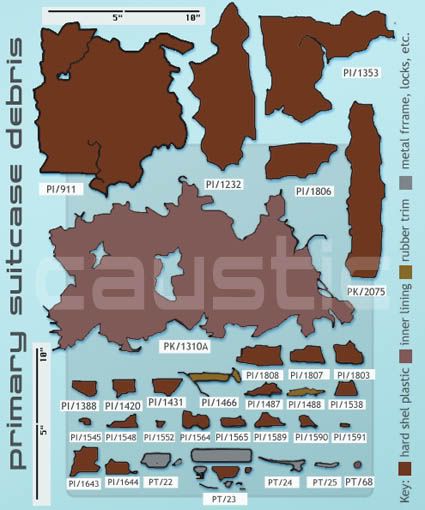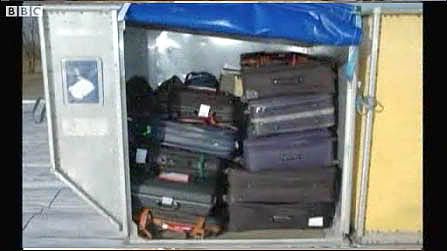This post will help establish a visual grasp of the evidence of Pan Am luggage loader John Bedford, and its possibly huge relevance to the Lockerbie bombing. [general post: the Bedford suitcase(s)] This is best understood if one has read the statements Bedford and a coworker made to London police shortly after the attack. The timeline of 21 December at the interline shed is also pivotal, but will be worked into this post as we go. In short, on that afternoon, a pair of brown, hard-shell Samsonite suitcases appeared in the same luggage container the blast would later occur in. And that has been ruled to be a brown hard-shell Samsonite case. No other such bags were found in that container. Neither of the two baggage handlers who worked at interline would say just where these bags came from, as their stories conflicted and shifted over time.
So just to be able to better "see" what this might mean...
The Container
The aircraft in question, known as Clipper Maid of the Seas, was a Boeing 747-121 model. According to Wikipedia, a 747-121 holds 30 cargo containers of the LD1 or LD3 style, fifteen along each side of the hold. A cross-section photo there helps explain the containers' non-rectangular shape - the lower outer corners are "cut off," creating a slanted portion of floor on the outboard (closer to the hull) end of the container.
Container AVE 4041 was blown out at just that end, the unluckiest of spots as far as the plane and those in it are concerned. To visualize this, AVE 4041 was a Pan Am-owned model LD3 container (or load device unit), of aluminum contruction, with the following dimensions, per a Wikipedia page:
base width / overall width - 61.5 / 79 inches
depth - 60.4 inches
height - 64 inches
The dimensions given in the AAIB report of 1990 are slightly different, and included in the figure below. The opened loading side is secured for flight with a blue sheet attached to cables that pulls down and latches. This open side is called the front by Loaders.
Below is one of these containers, used by Dr. John Wyatt in his recent fragment survivability tests. He's filled it with luggage and one case with a bomb, for the finale of a 20-test series. Note here the cases are not stacked spines down but flat-down. It's possible anyone could have rearraged the bags after Bedford's and Kamboj's placements - and a flat-stacked approach seems the best fit for the evidence - in the position here of the second lowest left-hand case, if slid to the left a bit. This image also helps establish a rough average suitcase thickness of around 8 inches, which I use below.
Visualizations
Using the dimensions of the pallet's base, as seen from above, it's possible to get some grasp of hw this would actually look. Below I've done some muck-ups, using the floor damage sketches from the AAIB's appendix F. The post linked there is another important part of being able to visualize this scenario. The blast damage to the container is crucial to understanding where inside of it the blast happened.
First, just the base we'll be working with. On the main floor, the blue area is the outer edge of floor deformation from the blast itself; other deformations were likely from the fall and the landing. The yellow is an "area of intense distortion, influenced by aircraft structure under panel." This was apparently shielded from direct blast effects by the lower suitcase beneath the primary one. Red is the area where the base edge member is "severely blast damaged." Areas slant-shaded are those never found (I re-did the overhang to ignore Claiden's silly PI/100 inclusion). Most of this panel was obliterated and never found, the rest was blown outward.
At left is the container as Bedford left it around 4pm, to have tea with his boss Peter Walker, leaving his coworker Kamboj alone at the Pan Am station. The exact number of bags he placed has never been pinned down, "four or five" total (per Kamboj), or a high "8-10" after Kamboj's two additions (per Bedford). Five to start plus the two is the estimation I chose. "Spines down handles up" was Bedford's style, he said, and placing them "along the back of the container" is best read as shown here. A left-to-right order isn't specified or necessary, but it does fit the other clues a bit better than right-to-left scheme.
The sample size I'm using for these filler cases is 16x24x8 inches. It's reasonable but quite imprecise, and in reality different bags will be different sizes and shapes. Please note the rough correlation of the area covered by these and the area not as blast-warped. The yellow and blue tend to a circular pattern radiating from the center, except where these upright bags were. These would transfer force much differently from flat laid cases beneath the bomb.
Upon Bedford's return around 4:40 pm the arrangement was something like this. Two new "hard cases, the type Samsonite make" had been added on the floor as shown here. I'm using the primary case dimensions - silhouette 4000 series, 26x22x9 inches (see link at top, above the video). We cannot say that's not what he saw. With the same style and color (brown or maroony brown) and their appearance together they might well be a matching set, which is worthy of note (and yet little noted thus far). Laid side by side, at the front of the container, to the left, handles pointing towards the back, "they took up the remaining base area of the tin," Bedford told police. These do just that.
We know they weren't left here, so close to the later explosion, or they'd turn up bomb damaged, which they didn't. Or perhaps they did, as this whole exercises is premised on wondering...
To conserve space, a later worker may have rearranged the cases like the mock-up at left: stacked together and slid left and back against the other cases and the overhang floor. Geometrically, it puts the upper case's (approximate) middle in the IED location (the flare here). Given the nearly-square shape of the primary case, there is little difference between them ending up long end sticking outboard (as shown here) or the other way around (as shown below). In both arrangements, a 180 degree rotation is also just as good a fit, giving us four possible variations.
The arrangement at left with an added 90-degree rotation (this or its base-out inversion) has the blast area more high-centered than left, and makes a little more sense in a way. But good clues I stumbled across suggest the above image or its reverse might have to be it. It seems that parts from both the handle and hinge (bottom) ends of the case left pieces blasted into surrounding luggage. Pieces of the lock wound up in a suitcase from within this container, and a piece of the bottom wound up in the container over (down as shown here), and apparently piercing a "purple holdall." Both are consistent with handles-in placement like Bedford saw.
 Finally, the obvious point that we're visualizing two cases, while only the remains of one were recovered. So it seems. Consider this hypothesis - approximately one-and-a-half of these two cases was basically vaporized by a blast maybe 50% more powerful than believed. Highly energized suitcase material wouldn't disappear, but may alight in a variety of states you'd never recover: drifting flakes of melted plastic, and small non-descript "pebbles" that vanish into sandy mud. Drifting might continue to the North sea, or into a loch.
Finally, the obvious point that we're visualizing two cases, while only the remains of one were recovered. So it seems. Consider this hypothesis - approximately one-and-a-half of these two cases was basically vaporized by a blast maybe 50% more powerful than believed. Highly energized suitcase material wouldn't disappear, but may alight in a variety of states you'd never recover: drifting flakes of melted plastic, and small non-descript "pebbles" that vanish into sandy mud. Drifting might continue to the North sea, or into a loch.Larger pieces can and would be recovered, and here we see a couple dozen bits less than an inch in size, but most of these were found blasted into other suitcases, not laying in the grass, or caught in a tree's canopy. The nearly 1/2 of an entire suitcase assembled (mock-up at left) is primarily just five fragments, one nearly a foot square. And there is a 20-inch span of gossamer fabric lining. Which half of the primary case could that be from? Top or bottom? Any takers? Why the asymmetry?
And that large chunk at upper left, PI/911, has an extremely interesting history of its own - RARDE first said it was from a case beneath the primary one and was touching the floor. Wait 'til you see why that changed.
Investigators had no way of knowing such rearrangements didn't happen, but by accepting Bedford's story, had to presume these cases had been near that corner and were then moved somewhere. They were never able to find where these cases went to if not where these above images show. Yet they ruled out the possibility by concluding a bomb case that wasn't touching the (main) floor, and had to have come from Frankfurt, in a third brown hard-shell Samsonite to have occupied that corner.
It's utter hogwash thinking of a suspiciously wishful sort. How early did the police bosses know London must be cleared, and for what reason?
---









No comments:
Post a Comment